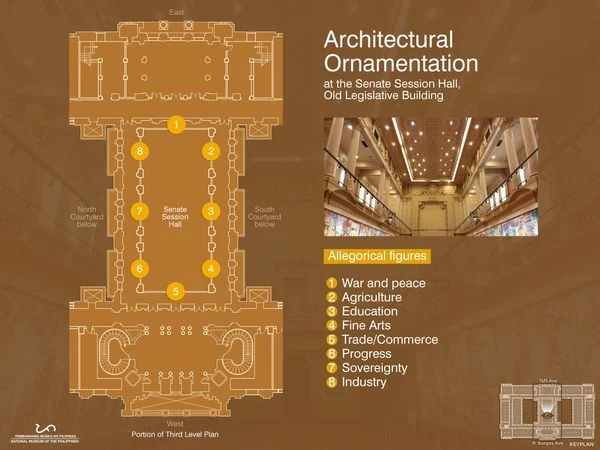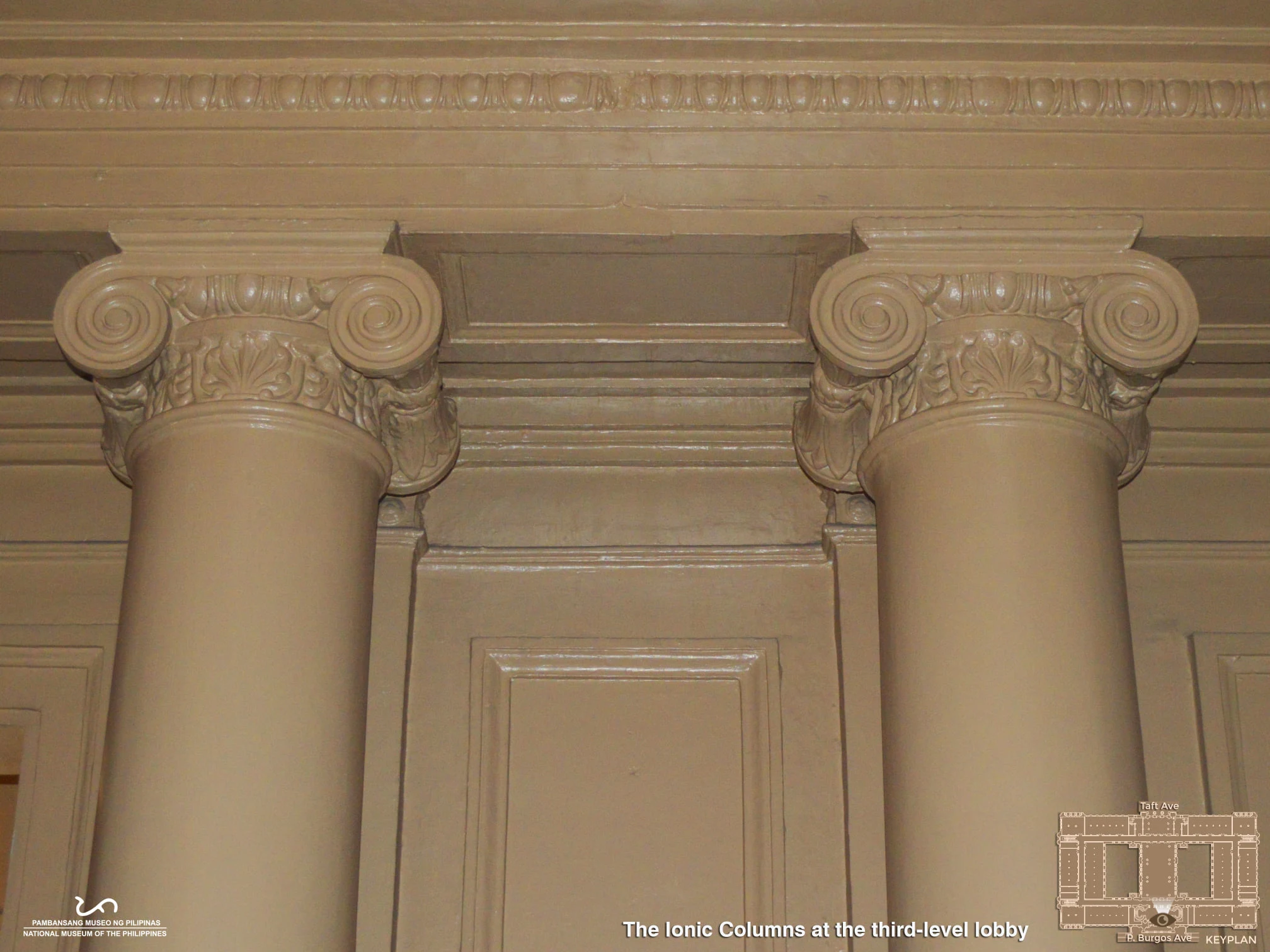Architectural Ornamentation - National Museum of Fine Arts (formerly the Old Legislative Building - Philippines)
 |
| The Old Senate Session Hall Plan |
Dictates of proportion, symmetry, and order form the trabeated architectural interiors, with ornate neoclassical entablature, enriched by the use of local motifs. The interiors exhibit the sculptural work of the Tampincos, Isabelo and his sons, Angel and Vidal; which articulates Juan Arellano’s design. The ornamentation showcases the Tampincos’ creative excellence made distinct by the incorporation of native elements.
Architectural ornamentation of the interiors, such as bas-relief and sculptural figures, are of cast concrete. The new building technology, introduced in the American Colonial Period, made the recurrent articulation easier to execute through modeling and casting. According to Santiago Albano Pilar, “modeling or modelado is achieved by manually creating shapes through adding and subtracting from a malleable medium such as clay (barro) or plaster of Paris (yeso; escayola). Consequently, vaciado, referred to as casting, produces multiple copies by moulding in permanent materials, such as plaster or concrete, on the model created.”
 |
| Main Entrance Hall |
The main entrance hall welcomes with pairs of columns in Corinthian orders and surrounding entablature. The Corinthian order is distinct of the heavy foliage articulation, the unfurled acanthus leaves. Ornamentation of the entablature exemplifies grandiosity through elaborate bas-relief sculptures of neoclassical motifs such as angels, cartouches, garland or festoon, flowers, and leaves. Walls of the four corners of the space also feature a framed sphinx.
 |
| Main Entrance Hall Entablature |
As pairs of columns grace the entrance halls, it serves as a visual cue leading to the central space. Located at the core of the Old Legislative Building’s second level and flanked by the north and south courtyards, the Session Hall of the House of Representatives features the Corinthian order supported by a rectangular shaft.
 |
| Old Session Hall of the House of Representatives ceiling |
The coffered ceiling has relief works of rosettes, cartouches, and foliage.
Motifs of neoclassical design articulate the building’s hallways as well. On the portals that serve as a gateway to the other galleries and the courtyard, a bas-relief on the transom depicts a design referred to as putto, plural form: putti, which is an Italian term and a representation for a chubby and naked male child. On the transom, Putti are placed on either side of a rectangular cartouche.
 |
| Ionic columns |
The use of the Greek orders on the lobbies of the building displays the hierarchy of spaces. On the third-level entrance hall, the space is decorated with the Ionic order, differentiated by the scroll or volute in its capital, arranged in a single plane. In between the volutes is an egg and dart moulding with a band of leaf moulding at the bottom.
 |
| Tuscan columns |
Moreover, on the fourth level, the hall is adorned with the Tuscan order supporting a series of arches.
 |
| View of the eastern side of the Old Senate Session Hall |
Grandeur grace the Senate Session Hall, adding to the massive hall’s visual feat. The frieze is filled with allegorical figure sculptures, decorative cartouches, and statuaries of personages, rulers, and lawmakers from history and antiquity.
 |
| Sculptures representing Agriculture, Old Senate Session Hall |
The Tampincos’ magnum opus at the Senate Session Hall’s entablature displays 8 plaster cast of allegorical figures on war and peace, agriculture, education, art, trade, progress, sovereignty, and industry. One example, the allegorical figures that depict ‘agriculture’, include indigenous motifs and iconographies. The vestments and objects are representational of Filipino motifs. The female figure is seen in baro’t saya holding a cornucopia of native fruits representing bountiful harvest, sitting beside a banana leaf. On the other hand, the male figure, represents god, Hermes, is wearing a petasos or sun hat, and sitting with a goat on his right-hand side.

Sculptures representing Art, Old Senate Session Hall
Another allegorical high-relief illustrates the ‘fine arts’. The symmetrical figures display the classical proportion of the human body. A female figure on the left holds a palette and the other holds a sculptural piece, denoting to represent the visual arts, painting, and sculpture.
 |
| Sculptures representing Sovereignty, Old Senate Session Hall |
On the opposite wall, an allegory on ‘sovereignty’ is depicted by a male figure with his right hand holding a weapon and his clenched left fist holds a shield or kalasag. The other figure, a woman carrying her infants, shows a gesture of being protective of her own.
 |
| Cartouche, Old Senate Session Hall |
The seal flanked by standing historical figures features a garland attached to the top scroll and a pair of cornucopias. The cornucopia holds indigenous produce such as mangga (mango), kasoy (cashew), balimbing (star fruit), and atis (sugar-apple), among others. At the center of the cartouche bears emblems similar to the Great Seal of the United States, the star and the eagle.
The architectural interior exemplifies the creativity of the Filipino sculptors, Isabelo Tampinco and his sons, Angel and Vidal Tampinco, to create and shape cast concrete ornamentations as interpretation and articulation of neoclassical architecture.
Outstanding artistry waits for your appreciation once we are authorized to open the museum halls for visit. For now, we hope this poses a visual treat of the exemplary Filipino ingenuity and finesse as we appreciate the #MuseumFromHome.
________________
Text by Ar. Bernadette B. Balaguer and photos by Erick E. Estonanto | NMP AABHD
© National Museum of the Philippines (2021)


No comments:
Got Something to Say? Thoughts? Additional Information?